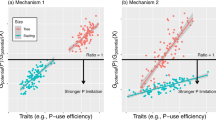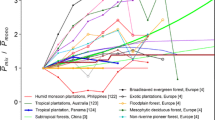Abstract
The interplay and balance between positive and negative interactions are important and recurrent topics in plant ecology. If facilitation occurs because benefactors ameliorate stress, such balance may be driven by seed mass because stress tolerance and competitive ability of plants, particularly seedlings, are positively correlated with seed mass. Thus, small-seeded, stress-intolerant species may require facilitation, but not large-seeded ones. This would equalise the magnitudes of opposite-signed interactions because in small-seeded species, positive effects of facilitators and negative effects of competitors should be strong, while both effects should be weak in large-seeded species. To test this idea, we assessed the effects of interactions with four associated species on different components of the performance of ten focal species. As expected, the largest facilitative and competitive effects were recorded in small-seeded species, and positive interactions had similar magnitudes to negative ones for any given seed mass, especially when performance was integrated into lifelong fitness. Furthermore, the fact that small-seeded species seem to be strongly facilitated may explain why they are not outcompeted by large-seeded species. This is an alternative to other hypotheses explaining the coexistence of plants with different-sized seeds. The close balance between opposite-signed interactions in the presence of stress may also explain why interactions have strong effects on individuals (that interact with only a few species), but seemingly weaker effects on populations, where interactions between many species would cancel out.



Similar content being viewed by others
References
AGTA (2012) Keys to fieldwork. McMillan Education, South Yarra
Baskin CC, Baskin JM (2014) Seeds: Ecology, biogeography, and evolution of dormancy and germination, 2nd edn. Academic Press, San Diego
Bolker B, R Development Core Team (2012) bbmle: tools for general maximum likelihood estimation, 1.0.5.2 edn. R package
Brooker RW et al (2008) Facilitation in plant communities: the past, the present, and the future. J Ecol 96:18–34. https://doi.org/10.1111/j.1365-2745.2007.01295.x
Bruno JF, Stachowicz JJ, Bertness DM (2003) Inclusion of facilitation into ecological theory. Trends Ecol Evol 18:119–125. https://doi.org/10.1016/S0169-5347(02)00045-9
Buckley RC (1982) Seed mass and seedling establishment in tropical arid dunecrest plants. Biotropica 14:314
Burnham KP, Anderson DR (2002) Model selection and multimodel inference: a practical information-theoretic approach. Springer, New York
Calcagno V, Mouquet N, Jarne P, David P (2006) Coexistence in a metacommunity: the competition–colonization trade-off is not dead. Ecol Lett 9:897–907. https://doi.org/10.1111/j.1461-0248.2006.00930.x
Callaway RM (1995) Positive interactions among plants. Bot Rev 61:306–349. https://doi.org/10.1007/BF02912621
Callaway RM (2007) Positive interactions and interdependence in plant communities. Springer, New York
Chapin FS III (1991) Integrated responses of plants to stress. A centralized system of physiological responses. Bioscience 41:29–36
Choler P, Michalet R, Callaway RM (2001) Facilitation and competition on gradients in alpine plant communities. Ecology 82:3295–3308. https://doi.org/10.1890/0012-9658(2001)082%5b3295:FACOGI%5d2.0.CO;2
Comita LS, Muller-Landau HC, Aguilar S, Hubbell SP (2010) Asymmetric density dependence shapes species abundances in a tropical tree community. Science 329:330–332. https://doi.org/10.1126/science.1190772
Cruz-Cisneros R, Rzedowski J (1980) Vegetación de la Cuencia del Río Tepelmeme, Alta Mixteca, Estado de Oaxaca, México. An Esc Nac Cienc Biol Mex 22:19–84
Eriksson O, Ehrlén J (1992) Seed and microsite limitation of recruitment in plant populations. Oecologia 91:360–364. https://doi.org/10.1007/BF00317624
Eriksson A, Eriksson O (1997) Seedling recruitment in semi-natural pastures: the effects of disturbances, seed size, phenology and seed bank. Nord J Bot 17:469–482. https://doi.org/10.1111/j.1756-1051.1997.tb00344.x
Facelli JM (2008) Specialized strategies. I. Seedlings in stressful environments. Seedling ecology and evolution. Cambridge University Press, Cambridge, pp 56–78. https://doi.org/10.1017/CBO9780511815133
Fayolle A, Viole C, Navas ML (2009) Differential impacts of plant interactions on herbaceous species recruitment: disentangling factors controlling emergence, survival and growth of seedlings. Oecologia 159:817–825. https://doi.org/10.1007/s00442-008-1254-0
Freckleton RP, Watkinson AR (2000) On detecting and measuring competition in spatially structured plant communities. Ecol Lett 3:423–432. https://doi.org/10.1046/j.1461-0248.2000.00167.x
Freckleton R, Watkinson A (2001a) Predicting competition coefficients for plant mixtures: reciprocity, transitivity and correlations with life-history traits. Ecol Lett 4:348–357. https://doi.org/10.1046/j.1461-0248.2001.00231.x
Freckleton RP, Watkinson AR (2001b) Nonmanipulative determination of plant community dynamics. Trends Ecol Evol 16:301–307. https://doi.org/10.1016/S0169-5347(01)02146-2
García-Meza D, Martorell C (2016) A trade off in the absolute magnitudes of seed and microsite limitations and their effects on population regulation. Oikos 125:308–314. https://doi.org/10.1111/oik.02815
Goldberg DE, Scheiner SM (2001) ANOVA and ANCOVA: field competition experiments. In: Scheiner SM, Gurevitch J (eds) Design and analysis of ecological experiments. Oxford University Press, Oxford
Grime JP (1977) Evidence for the existence of three primary strategies in plants and its relevance to ecological and evolutionary theory. Am Nat 111:1169–1194. https://doi.org/10.1086/283244
Gross KL (1984) Effects of seed size and growth form on seedling establishment of six monocarpic perennial plants. J Ecol 72:369–387. https://doi.org/10.2307/2260053
Harper JL (1977) Population biology of plants. Academic Press, New York
Harper J, White J (1974) The demography of plants. Annu Rev Ecol Evol Syst 5:419–463. https://doi.org/10.1146/annurev.es.05.110174.002223
Hart SP, Marshall DJ (2013) Environmental stress, facilitation, competition, and coexistence. Ecology 94:2719–2731. https://doi.org/10.1890/12-0804.1
He Q, Bertness MD, Altieri AH (2013) Global shifts towards positive species interactions with increasing environmental stress. Ecol Lett 16:695–706. https://doi.org/10.1890/12-0804.1
Hedges LV, Gurevitch J, Curtis PS (1999) The meta-analysis of response ratios in experimental ecology. Ecology 80:1150–1156. https://doi.org/10.1890/0012-9658(1999)080%5b1150:TMAORR%5d2.0.CO;2
Keddy PA (2001) Competition. Kluwer, Dordrecht
Kunstler G et al (2016) Plant functional traits have globally consistent effects on competition. Nature 529:204. https://doi.org/10.1038/nature16476
Law R, Herben T, Dieckmann U (1997) Non-manipulative estimates of competition coefficients in a montane grassland community. J Ecol 85:505–517. https://doi.org/10.2307/2960573
Leishman MR (2001) Does the seed size/number trade-off model determine plant community structure? An assessment of the model mechanisms and their generality. Oikos 93:294–302. https://doi.org/10.1034/j.1600-0706.2001.930212.x
Leishman MR, Wright IJ, Moles AT, Westoby M (2000) The evolutionary ecology of seed size. In: Fenner M (ed) The ecology of regeneration in plant communities. CAB International, Wallingford, pp 31–57
Levine JM, Murrell DJ (2003) The community-level consequences of seed dispersal patterns. Annu Rev Ecol Evol Syst 34:549–574. https://doi.org/10.1146/annurev.ecolsys.34.011802.132400
Liancourt P, Callaway RM, Michalet R (2005) Stress tolerance and competitive-response ability determine the outcome of biotic interactions. Ecology 86:1611–1618. https://doi.org/10.1890/04-1398
Martínez-López M (2014) Efecto del tamaño de la semilla sobre la tolerancia al estrés hídrico en hierbas de un pastizal semiárido, Master in Biological Sciences. UNAM, Mexico City, p 74
Martorell C, Freckleton R (2014) Testing the roles of competition, facilitation and stochasticity on community structure in a species-rich assemblage. J Ecol 102:74–85. https://doi.org/10.1111/1365-2745.12173
Martorell C, Zepeda V, Martínez-Blancas A, García-Meza D, Pedraza P (2017) A diversity world record in a grassland at Oaxaca, Mexico. Bot Sci 95:1–7. https://doi.org/10.17129/botsci.689
May RM (2001) Stability and complexity in model ecosystems. Princeton university press
McIntire EJ, Fajardo A (2014) Facilitation as a ubiquitous driver of biodiversity. New Phytol 201:403–416. https://doi.org/10.1111/nph.12478
Metz J, Liancourt P, Kigel J, Harel D, Sternberg M, Tielbörger K (2010) Plant survival in relation to seed size along environmental gradients: a long-term study from semi-arid and mediterranean annual plant communities. J Ecol 98:697–704. https://doi.org/10.1111/j.1365-2745.2010.01652.x
Michalet R et al (2006) Do biotic interactions shape both sides of the humped-back model of species richness in plant communities? Ecol Lett 9:767–773. https://doi.org/10.1111/j.1461-0248.2006.00935.x
Moles AT, Westoby M (2004) Seedling survival and seed size: a synthesis of the literature. J Ecol 92:372–383. https://doi.org/10.1111/j.0022-0477.2004.00884.x
Rees M (1995) Community structure in sand dune annuals: is seed weight a key quantity? J Ecol 83:857–863. https://doi.org/10.2307/2261422
Rees M, Westoby M (1997) Game-theoretical evolution of seed mass in multi-species ecological models. Oikos 78:116–126
Rees M, Grubb PJ, Kelly D (1996) Quantifying the impact of competition and spatial heterogeneity on the structure and dynamics of a four species guild of winter annuals. Am Nat 147:1–32. https://doi.org/10.1086/285837
Schöb C, Kammer PM, Kikvidze Z, Choler P, Von Felten S, Veit H (2010) Counterbalancing effects of competition for resources and facilitation against grazing in alpine snowbed communities. Oikos 119:1571–1580. https://doi.org/10.1111/j.1600-0706.2010.18288.x
Silvertown JM, Franco M, Pisanty I, Mendoza A (1993) Comparative plant demography - relative importance of life-cycle components to the finite rate of increase in woody and herbaceous perennials. J Ecol 81:465–476. https://doi.org/10.2307/2261525
Tilman D (1982) Resource competition and community structure. Princeton University Press, Princeton
Turnbull L, Rees M, Crawley MJ (1999) Seed mass and the competition/colonization trade-off: a sowing experiment. J Ecol 87:899–912. https://doi.org/10.1046/j.1365-2745.1999.00405.x
Villarreal-Barajas T, Martorell C (2009) Species-specific disturbance tolerance, competition, and positive interactions along an anthropogenic gradient. J Veg Sci 20:1027–1040. https://doi.org/10.1111/j.1654-1103.2009.01101.x
Volkov I, Banavar JR, Hubbell SP, Maritan A (2009) Inferring species interactions in tropical forests. Proc Natl Acad Sci USA 106:13854–13859. https://doi.org/10.1073/pnas.0903244106
Wang Y, Chu C, Maestre FT, Wang G (2008) On the relevance of facilitation in alpine meadow communities: an experimental assessment with multiple species differing in their ecological optimum. Acta Oecol 33:108–113. https://doi.org/10.1016/j.actao.2007.10.002
Westoby M, Jurado E, Leishman MR (1992) Comparative evolutionary ecology of seed size. Trends Ecol Evol 7:368–372. https://doi.org/10.1016/0169-5347(92)90006-W
Westoby M, Leishman M, Lord J, Poorter H, Schoen DJ (1996) Comparative ecology of seed size and dispersal [and discussion]. Proc R Soc B 351:1309. https://doi.org/10.1098/rstb.1996.0114
Wilson JB (1999) Assembly rules in plant communities. In: Weiher E, Keddy PA (eds) Ecological assembly rules: perspectives, advances, retreats. Cambridge University Press, Cambridge
Yu DW, Wilson HB (2001) The competition-colonization trade-off is dead; long live the competition-colonization trade-off. Am Nat 158:49–63. https://doi.org/10.1086/320865
Zanne AE, Chapman CA, Kitajima K (2005) Evolutionary and ecological correlates of early seedling morphology in East African trees and shrubs. Am J Bot 92:972–978. https://doi.org/10.3732/ajb.92.6.972
Acknowledgements
L. F. V. V. Boullosa, D. García-Meza, E. García-Morales, F. Herce, A. Martínez, M. Martínez, E. Montoya, A. Navarrete, E. Lezama, M. Ramos, B. Santini, A. Torres and B. Vázquez helped us during fieldwork. M. A. Romero provided computational support, O. Briones, Z. Cano-Santana, C. Montaña, P. L. Valverde, M. T. Valverde, W. Dawson and three anonymous reviewers provided valuable comments. Consejo Nacional de Ciencia y Tecnología (CONACyT) provided VZ a fellowship during her master’s degree. She also thanks Posgrado en Ciencias Biológicas. This project was funded by Programa de Apoyo a Proyectos de Investigación e Innovación Tecnológica de la Universidad Nacional Autónoma de México (PAPIIT-UNAM IN225511). Agradecemos a la comunidad de Concepción Buenavista por su invaluable apoyo.
Author information
Authors and Affiliations
Contributions
CM and VZ conceived the research, and VZ collected and analysed the data. Both authors contributed to preparing the manuscript.
Corresponding author
Ethics declarations
Conflict of interest
The authors declare that they have no conflict of interest.
Additional information
Communicated by Wayne Dawson.
We show that the magnitude of competition and facilitation among co-occurring grassland species varies with seed mass. This suggests that these interactions may cancel out when multiple species are involved. Our results provide new insights into the effects of seed mass and species interactions on processes of community assembly and coexistence.
Electronic supplementary material
Below is the link to the electronic supplementary material.
Rights and permissions
About this article
Cite this article
Zepeda, V., Martorell, C. Seed mass equalises the strength of positive and negative plant–plant interactions in a semi-arid grassland. Oecologia 190, 287–296 (2019). https://doi.org/10.1007/s00442-018-04326-4
Received:
Accepted:
Published:
Issue Date:
DOI: https://doi.org/10.1007/s00442-018-04326-4




